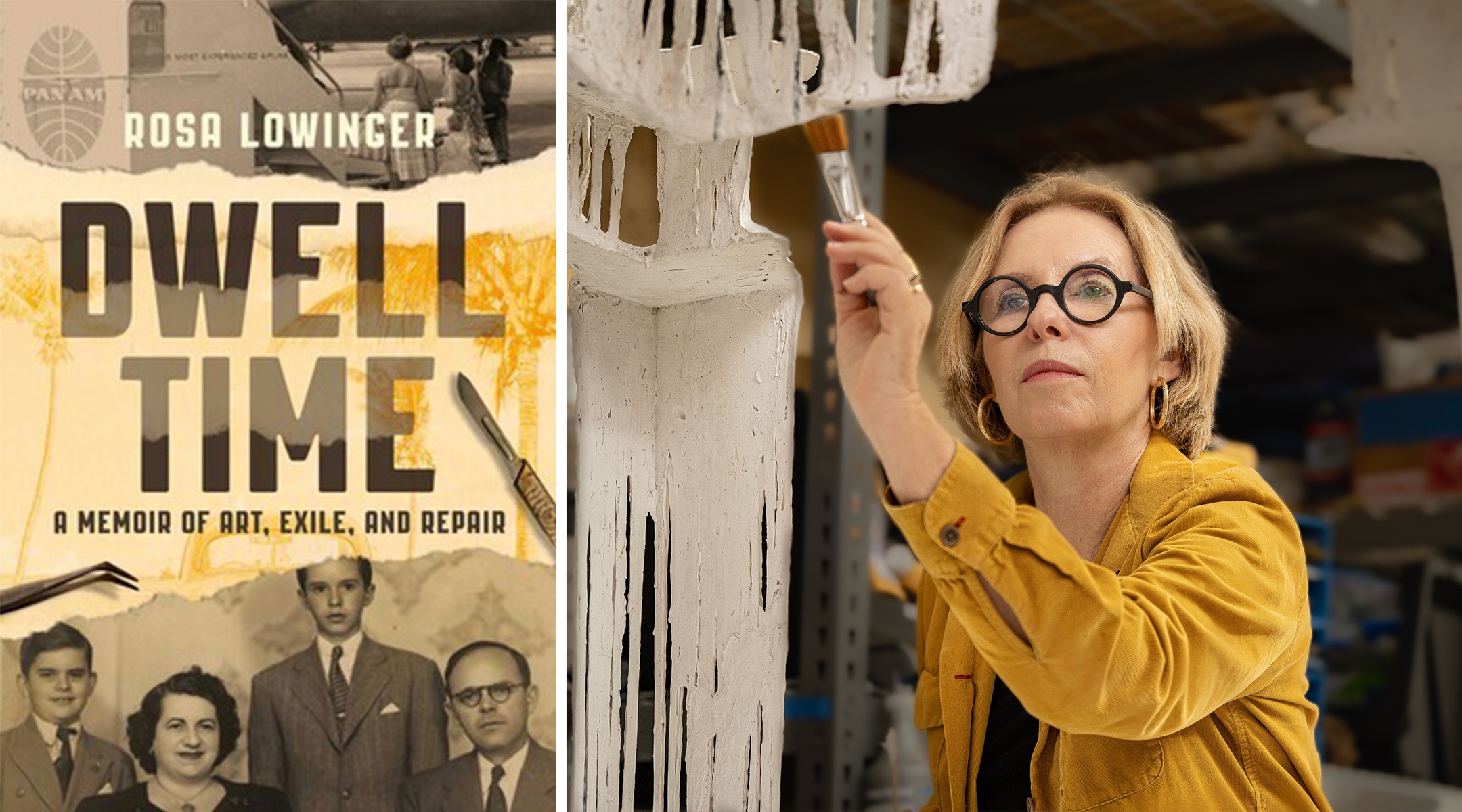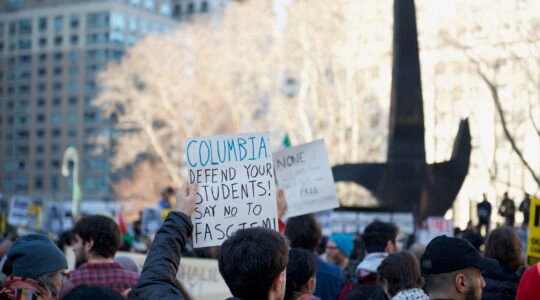(JTA) — In her recent book, “The Object of Jewish Literature,” Case Western Reserve University professor Barbara A. Mann writes about how “literature deploys physical objects as emblems of ideas, emotions, and psychological dramas about the self.” In other words, “things” matter: Furnishings, clothing, food and, in the case of Mann’s study, the glued or sewn-together bundles of paper we call books tell the stories of the people who made, bought and used them.
Rosa Lowinger knows this from a lifetime of study of how things are made and how they fall apart. An art conservator who specializes in sculpture and historic architectural materials, Lowinger has written a memoir of her Cuban-Jewish family that uses such materials — marble, concrete, bone, plastic — as organizing principles. Each chapter of “Dwell Time” takes its name and theme from one of those materials to tell how her family came to Cuba and fled after the revolution, and what they found and lost when they settled in Miami.
She also examines with a conservator’s eye — appreciatively, but looking for cracks and flaws — her own shortcomings as a daughter, wife and businesswoman.
“Terrazzo is robust, but it yields easily to gouges and cracks from settling or expansion,” she writes in a typical passage. “It’s hard to fix without leaving enormous scars. It reminds me of my family, those Eastern Europeans who left for America and found themselves settled in the tropics, only to be forced to bust out of their foundation within a few decades. It’s true of my profoundly damaged mother, who had the spark of inspiration and presence of mind to know when it was time to flee the country of her birth, but has a way of smashing relationships to smithereens.”
Three generations of her family, beginning with her paternal grandfather Avrom Lövinger’s arrival from Cluj in northern Transylvania, lived in Cuba — which was still taking in Jews when the United States had closed its doors. Her Cuban-born mother, Hilda Peresechensky, spent her youth in an orphanage founded in the early 1920s as a home for poor Ashkenazi Jewish women. She attended a Jewish high school on a scholarship, experiencing periods of poverty that would haunt her the rest of her life.
The author’s father, Leonardo “Lindy” Lowinger, was born in Santiago de Cuba in 1932, and, putting aside his own dreams of being an architect, had a peripatetic career in the eyeglasses business as a salesman and occasional optician.
The Lowingers were middle-class Jews who by the mid-1950s were well-established members of Cuban society. Most of Cuba’s 20,000 Jews lived in Havana, a city, she writes, “that boasted Jewish schools, kosher restaurants, and three synagogues.”
After Castro came to power in 1959, he didn’t target Jews, but businesspeople like Lindy Lowinger saw a dim future under communism. In 1961, after a fraught flight, father, mother and young Rosa — born in 1956 — found a one-bedroom apartment in Miami Beach.
The exodus of most of the country’s Jews — and the Jewish history of the Cuba they left behind — has recently been the subject of several new books as a new generation of people with ties to the country make sense of their families’ stories. Aaron Hamburger’s “Hotel Cuba,” published in May, examines how his grandmother’s American Jewish identity was forged during a stint in Cuba in the 1920s. “Tia Fortuna’s New Home,” a children’s book by Ruth Behar published last year and distributed through PJ Library, tells the story of a contemporary grandmother facing dislocation for a second time after leaving Havana as a young woman. And AJ Sidransky’s “The Incident at San Miguel,” published in March, is historical fiction based on the real story of two Jewish brothers torn apart by the Cuban revolution — including one, like Rosa Lowinger’s family, who barely managed to flee.
As it did for many Cuban exiles, the exodus of Lowinger’s family left scars. She would later tell a friend that her father is “morose, suspicious, and we always have money problems.” Meanwhile, Hilda was beautiful and resourceful, but took out her frustration and disappointment on her daughter. “My mother’s punishments were laced with turbulence beyond her control, a violence born of pure rage at the world that had betrayed her, the sort of thing that feels like it will escalate dangerously toward irrevocable tragedy,” writes Lowinger. “Though her behavior appeared sadistic and designed to terrorize, I see now that she was simply drowning in her own suffering.”
It’s a generous view of what appears to be child abuse, but the description seems part of Lowinger’s project to understand her family members, like her conservation projects, in all their dimensions. “There was also active kindness, humor, and generosity in my family,” she writes. “It was hard to see it, just as it’s hard to notice anything but the dents and cracks and gouges in an otherwise beautiful sculpture.”
As a child, Lowinger attended Jewish schools and practiced what she calls “a moderate form of Conservative Judaism.” By the time she was a teenager, Lowinger could not wait to leave Miami, and took off for Brandeis University in Massachusetts.
Lowinger went on to land an internship at the Metropolitan Museum of Art in New York, a fellowship at the W.F. Albright Institute for Archaeological Research in Jerusalem and a job at the Los Angeles County Museum of Art, and later launched a number of consulting businesses. Among her career highlights was the conservation of the Watts Towers, the monumental folk art sculptures in Los Angeles, and relocating a 100-foot-wide mosaic from the façade of Houston Methodist Hospital.
Lowinger would eventually marry and embark on a series of professional and personal journeys that would take her to Los Angeles, Israel, Philadelphia, Atlanta and Charleston, South Carolina. And yet, rarely at home in the cities she lived in, she was constantly drawn back to Cuba, mostly by its vivid but crumbling architecture but also by “the cloying nostalgia of Cuban exiles” that she once tried to escape.
“That place where I was born and that my parents left behind is forged from African, indigenous, Spanish, Chinese, French, North American, Ashkenazi, and Sephardic cultures,” she writes. “People who were fleeing from and coming toward. Builders, planters, innovators, tinkerers.”
Her mother, still alive and in her 90s at the book’s end, remains a huge presence in Lowinger’s life, a conservation project the author is never going to complete
“Try as I might, I can never get my mother to understand that conservation is not about repairing what is old. It’s about sustaining all fabric of human endeavor, what people treasure, where we live, and what we honor, no matter when it was made.”
“Dwell Time”’ takes its title from an art conservationists’ term meaning how long it takes for a cleaning product to do its work. Lowinger calls her book a “love story” to the profession of conservation, but it is also a guide to examining the Jewish past, understanding loss and appreciating the ways people and individuals can emerge stronger and sometimes more beautiful after decades of wear and tear.
JTA has documented Jewish history in real-time for over a century. Keep our journalism strong by joining us in supporting independent, award-winning reporting.







